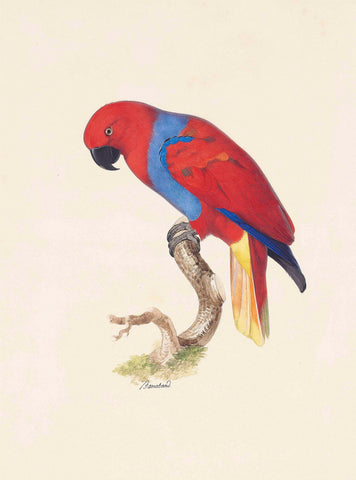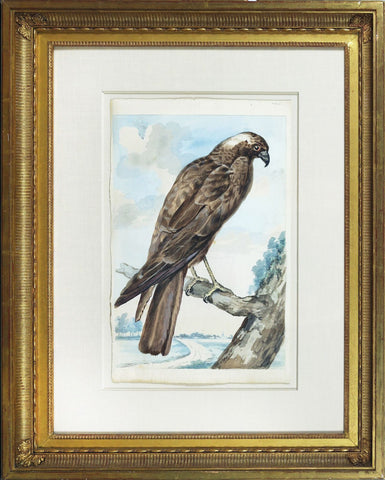
Jacques Barraband (French, 1767-1809), Female Eclectus Parrot (Eclectus roratus vosmaeri)
Jacques Barraband (French, 1767-1809)
Female Eclectus Parrot (Eclectus roratus vosmaeri)
Illustration for François Levaillant’s Histoire Naturelle des Perroquets, Paris, vol 2 (1805)
Plate 126, Le Perroquet grand Lori, mâle.
Signed ‘Barraband’ lower center
Pencil, watercolor and gouache on paper
Ca. 1800
Paper size 20 5/8 x 15 1/8 in
Frame size 30 1/4 x 25 1/4 in
Provenance: Marcel Jeanson (1885-1942); sale (‘Bibliothèque Marcel Jeanson Deuxième Partie Ornithologie’),
Sotheby’s, Monaco, 16 June 1988, lot 176 (illustrated in color on the catalogue cover).
The eclectus parrot is a parrot native to the Solomon Islands, Sumba, New Guinea and nearby islands, northeastern Australia and the Maluku Islands.
At the beginning of the nineteenth century, the explorer and ornithologist François Levaillant (1753-1824) created the then most compelling work on parrots, the Histoire Naturelle des Perroquets. The monograph was published by Levaillant between 1801 and 1805, comprised of two volumes and 145 plates. For the illustrations, Levaillant asked Jacques Barraband (1768-1809), as his bird watercolors were considered masterpieces of French ornithological illustration. Barraband was held to be one of the greatest bird illustrators of his time, impressing even Napoleon Bonaparte, who later became his patron.
Ornithological works had considerable appeal for educated readers, primed by several decades of writing which drew a symbolic connection between birds and ‘sensibility’. With Histoire Naturelle des Perroquets Levaillant focused solely on parrots. contributing vastly to the ever-increasing study of ornithology, a specialist field of natural history that had previously only been studied on a small scale. Combined with the discovery of new printing techniques, it met the new demand for beautifully produced works. This resulted in a monograph on parrots with outstanding comprehension, quality, and refinement. Levaillant’s bird books with lavishly colored illustrations formed a legacy hardly matched in the history of ornithological publication.
This watercolor is a lovely depiction of the vibrantly colored Eclectus parrot (Eclectus roratus, Müller 1776). This medium-sized parrot can be found in the Melanesia region and northeastern Australia. The Eclectus is a very unusual genus in the parrot family and has puzzled scientists for centuries. Of all parrots, the Eclectus parrot is the most sexually dimorphic. The colors of the plumage contrast vastly, which is such an oddity that it caused incorrect descriptions of the birds for decades. The males have a bright coral and yellow upper bill, red flanks, and mostly bright emerald green plumage. As for the females, they have virtually a complete opposite color scheme; a black bill and a predominately red coloration of varying shades, and most subspecies have beautiful blue or lavender-purple breast feathers. Even the eye color of the genders differs (ill. 1). Their head and breast feathers look like silky hair which makes them, combined with their bright colors, uniquely beautiful. Males and females differ so much that they were long thought to be different species. The first males were described by P. L. S. Muller in 1776. Even great naturalists like John Gould were tricked for a long time. It was not until 1874 that males and females of this species were finally united under the same name.
The Eclectus has an unusual and complex breeding culture, resulting in communal breeding, where uncles and aunts help rear young in a group family situation. Unique to this family of parrots, they are polygamous and polygynandrous. Their breeding strategy could be the reason for the sexual dimorphism. Presumably, the female is so vividly colored because she stays in her nest for up to 11 months out of the year and her bright plumage helps the males locate her. She rarely leaves her nest and is totally dependent on the males to feed her throughout the year. The males, being primarily green, blend in with the forest as they travel from nest to nest in hopes that one of the females may select him as a mate. Eclectus parrots are very intelligent birds and are classified among the top three parrots for talking ability, rivaling the African Grey and Amazon parrots. They have an empathetic nature and a laid-back personality that makes them very favorable as pets.
In his monograph, Levaillant included three Eclectus parrots; le Perroquet grand Lori and two other varieties of the species. Currently, nine subspecies of Eclectus parrots are recognized. The female on this watercolor has a lavender colored breast and a yellow vent and underside of the tail, therefore it can be identified as the Eclectus roratus vosmaeri. The Vosmaeri’s Eclectus is found in the northern and central Moluccas with the island of Halmahera having the dominant population. As noted before, naturalists have misgendered these birds in the past. In this case, Levaillant thought the bird to be a male. Due to his connections with the upper class of Holland and Paris, Levaillant was able to see multiple specimens of these birds, such as those of the renowned Dutch collector Jacob Temminck (1748-1822). Levaillant owned a specimen as well until he let it became part of the cabinet of the Jardin des Plantes.
With the Eclectus parrot, Barraband was able to portray a bird with an incredible beauty along with scientific accuracy that few ornithological artists have been able to achieve. The meticulous hand-coloring displays delicate modulations of tone and color, fine lines, and perfect craftsmanship. Its plumage has a richness, texture, and translucence, providing remarkable detail and incredibly subtle gradations of color. By painting the branch in a looser manner, he created a contrast that makes the bird itself seem more detailed. Indeed, the featured work is exceptional, as can be seen in the bright colors of the plumage, the smoothness of the dark bill, and the excellent manner in which the feet are drawn. Le Perroquet grand Lori is emblematic of Barraband’s works of art, particularly in his later period. Therefore, it is no wonder it was on the cover of the Sotheby’s 1988 auction catalog, with the sale of many of the greatest ornithological watercolors from the library of Marcel Jeanson ( (1885-1942). Later on, this work of art was in the possession of James Oswald Fairfax, a passionate connoisseur whose interest in the fine and decorative arts spanned eras, cultures, and continents. The birds pose is serene, elegant, but it simultaneously looks at the beholder as if it is keeping an eye on him. It perfectly reflects the calm yet intelligent nature of the Eclectus parrot. Levaillant and Barraband’s ability to produce such a fine example of this vibrantly colored parrot is a testament to the ornithologist’s knowing eye and the artist’s exceptional talent, as well as the brilliance of this historic collaboration.
Jacques Barraband (french, 1767-1809)
Jacques Barraband’s watercolors of birds are masterpieces of French ornithological illustration. Most of his stunning portraits were done for the distinguished ornithologist Francois Levaillant, who commissioned the artist to illustrate his landmark works on African ornithology, including the lavish and striking Histoire Naturelle des Perroquets. Images of African birds were popular in early 19th-century France both for their exoticism and for Africa’s interest that Napoleon’s campaigns were generating. The collaboration of Levaillant and Barraband represented a departure from previous ornithological texts in its emphasis on beauty and luxury, with sumptuously colored and flawlessly rendered birds.
The project was a massive undertaking, which required over 300 finished watercolors. Apart from their undoubted beauty, they display a scientific accuracy that few ornithological artists have matched since. Still, the meticulous hand-colored engravings in Levaillant’s publications could not reach the delicate modulations of tone and color, the fine lines, and perfect draftsmanship of Barraband’s original watercolors, which are exceptional in their richness and tonal variation. Each feather is described by dozens of parallel lines, providing remarkable detail and naturalistically textured color.
The key to Barraband’s renown was his success as an illustrator of luxurious bird books. In addition to illustrating Francois Levaillant’s Histoire naturelle des perroquets (1801-05), Barraband also executed the original watercolors for the ornithologist’s Histoire naturelle des oiseaux de paradis (Birds of Paradise, 1801-06). These splendid watercolors demonstrate Barraband’s unparalleled ability to render splendidly realistic images of exotic birds of all forms.
Barraband studied under Joseph Malaine and afterward worked as a draftsman in the Gobelin tapestry works. He painted porcelains exhibited at the Paris Salons from 1798 through 1806, and records at Sevres show that he supplied drawings to the factory there in 1806. He also decorated the dining-room in Napoleon’s chateau at St. Cloud. His work for Francois Levaillant was undoubtedly the climax of his career. His drawings for Levaillant’s splendid works placed him at the forefront of French ornithological artists at the beginning of the 19th century. As these flawless watercolors demonstrate, Barraband combined a high order’s artistic ability with good taste and a rare aesthetic sense.
or by email at loricohen@aradergalleries.
We Also Recommend





